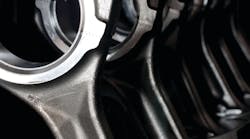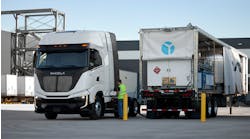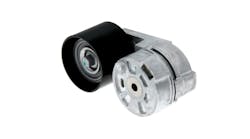No component within a heavy duty diesel engine takes as much abuse as the piston. The typical piston reaches a peak speed of between 4,000 and 5,000 ft/mi in normal operation. It accelerates from a dead stop to this peak speed, twice per revolution, or more than 80 times per second at 2,500 rpm – that's an acceleration of over 3000 Gs.
Now, add to that the incredibly harsh conditions a piston lives in: extremely high temperatures and combustion chamber pressures that could crush a submarine.
Until recently, the material of choice for internal combustion and diesel engine pistons was aluminum because of the advantages it offers: light weight, manages combustion temperatures well and pistons made from aluminum are easy to manufacture in large quantities.
However, beginning in 1999, diesel engine emission regulations significantly altered the operating conditions inside the combustion chamber. Temperatures and pressures increased significantly, necessitating a reevaluation of what material was the optimum choice for diesel pistons.
A Better Design
Initially, manufacturers came up with a two-piece, articulated piston, like MAHLE Ferrotherm pistons, which has a separate steel crown and an aluminum skirt. The piston pin fit through the free floating aluminum skirt and attached to the forged steel crown.
While this worked well, engineers found that the aluminum skirt actually wasn’t needed at all. An all-steel piston was the optimum solution.
Steel offers many noteworthy advantages compared to aluminum, including its strength. Ring land wear is not a concern with steel, and steel pistons expand at a similar rate to the engine bore.
However, steel weighs more than aluminum, and steel pistons are much more difficult to manufacture than ones made from aluminum.
One-piece steel pistons, like the MAHLE Original Monotherm piston, have a very distinctive appearance. First is the absence of a skirt. In its place are two “runners” down the sides.
Next, the piston is black all over. That is a special phosphate coating that provides lubrication during operation, and rust control before installation.
It is undesirable to have a steel pin riding in a steel bore. Steel against steel creates wear issues. Usually, you want to have steel running against babbit or tin plating.
Originally, the solution was to use a bushing inside the bore to create a wear surface, but the newest generation of pistons replaces the busing with a high-tech phosphate coating.
The phosphate coating enables the piston pin to ride without bushings and acts as a sacrificial lubricant. It provides protection against wear for well over 1,000,000 miles of operation.
“Profiled” Pin Bore
Another distinctive feature, not so visually apparent, is that the pin bore is “profiled.” Normally, a piston pin bore is straight.
If you view a cutaway of the bore on a steel piston, you would see that it is slightly trumpeted, increasing its diameter as it goes towards the outside of the piston.
This is needed since, although you have a massive 60mm piston pin, it still flexes minutely as it is subjected to the enormous forces acting on it. As the piston begins to rise on the compression stroke, the center of the pin is pushed up and the ends are cocked down.
The trumpet shape allows this flexing to occur without squeezing the lubricating oil film out, allowing for metal-to-metal contact. The profiling retains an oil layer, and compensates for the flexing.
Different Oil Cooling Design
Also not readily apparent is the “shaker plate” oil cooling design.
Aluminum pistons were able to provide adequate temperature control for the piston with squirters directing cooling lubricant at the open crown. Creating oil cooling passages in a forged piston is not feasible, so the shaker plate acts to retain oil in the crown, helping to cool the top of the piston.
Two holes in the plate allow the oil to drain back down into the oil pan. This feature was first used on the earlier, two-piece piston design and adds greatly to engine longevity and endurance.
Also adding to piston life is a special Grafal coating on the piston runners that reduces scuffing. Applied over the phosphate coating, it isn't visible to the human eye.
As noted previously, one of the few disadvantages of steel pistons is weight. But with the elimination of the skirt, overall piston weight can be reduced to the level of aluminum pistons.
Each piston is very highly balanced, ensuring the rotating components are all equally matched and resulting in a smooth running engine.
This new generation of lightweight, one-piece steel pistons represents a significant engineering accomplishment and allow today's highly efficient, clean diesel engines to deliver the promise of million-mile service.



